Make Beef Bone Broth for Pho
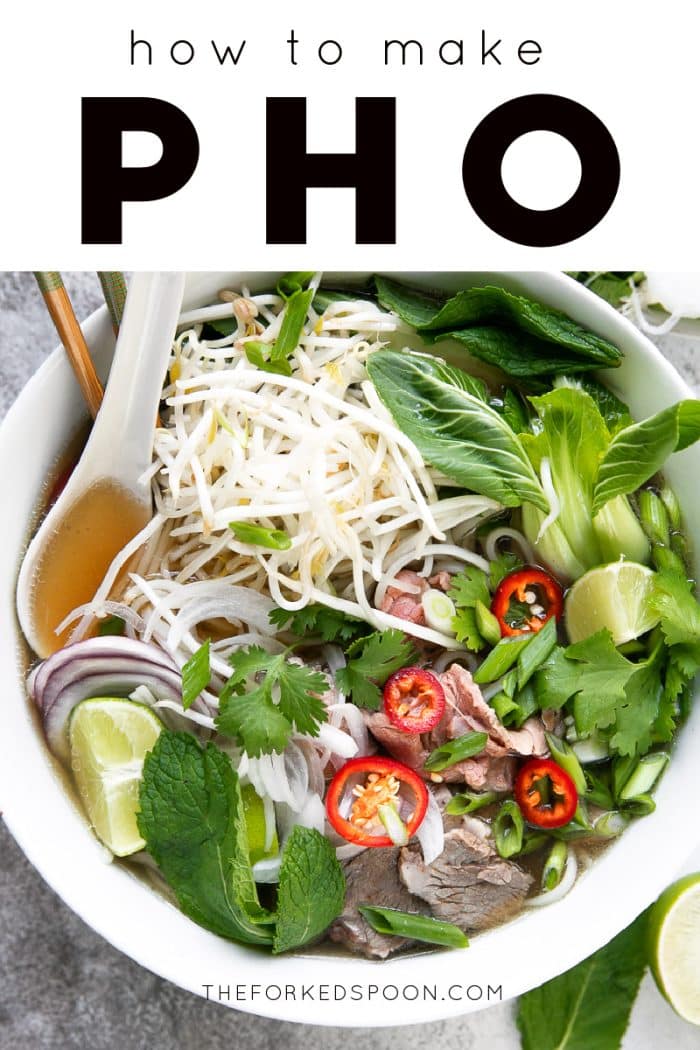
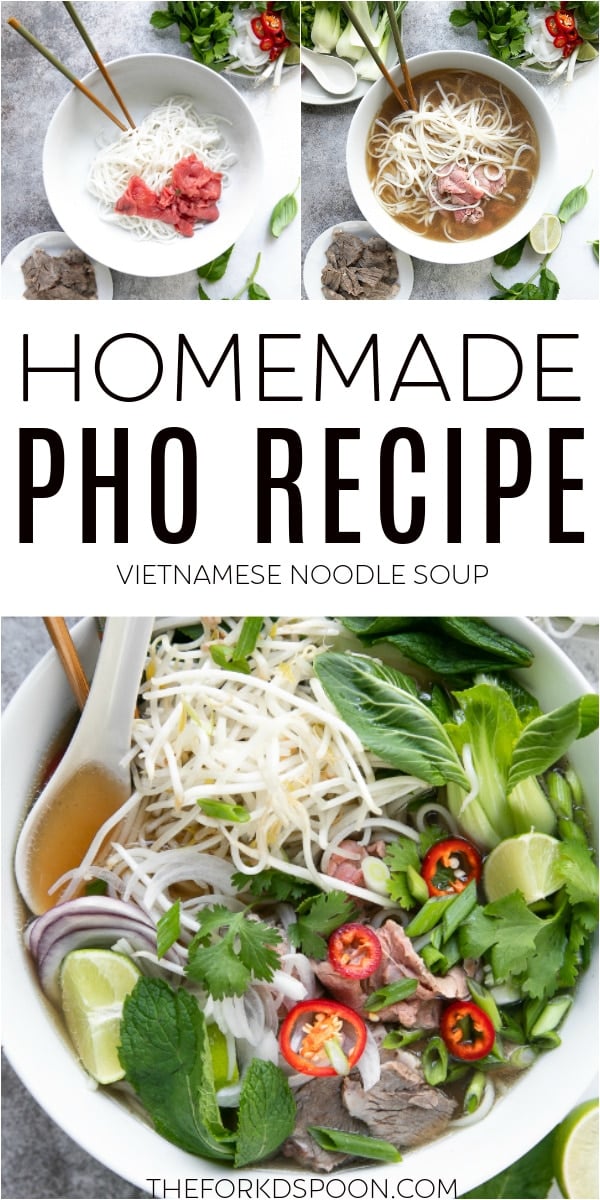


This unbelievably delicious Vietnamese Pho Recipe is made with a nourishing beef broth infused with fragrant spices, chewy noodles, and tender slices of meat. Filled with the same delicious and authentic flavors as your favorite pho restaurant, learn how to make this Vietnamese Noodle Soup from scratch and serve topped with fresh herbs and vegetables.

Pho Recipe
Pho (pronounced"fuh") is a popular Vietnamese Noodle Soup and a recipe truly worth learning how to master. Filled with layers of effluvious and complex flavors, the cardinal to whatsoever skillful pho recipe is the broth.
In this post, I will share 2 methods for making pho broth.
The first, more authentic version, is lengthy only completely worth the extra effort if you're looking to duplicate the pho from your favorite Vietnamese restaurant. The method is nearly identical to making bootleg bone goop and comes packed with tons of nutritional benefits. The recipe makes a lot of goop, so cut in half or freeze the leftovers for a rainy 24-hour interval.
The second, less authentic (translation: non at all authentic), version, is a fast and like shooting fish in a barrel 20-minute goop inspired by my bok choy soup recipe. Perfect for terminal-minute cravings, this version lacks much of the nutritional benefits of the higher up but information technology'south there for you when y'all're in a hurry.
If this is your first time trying Vietnamese noodle soup, I recommend trying the fast version to get-go. Information technology includes several of the same spices, so you'll go an idea for the overall taste and season.
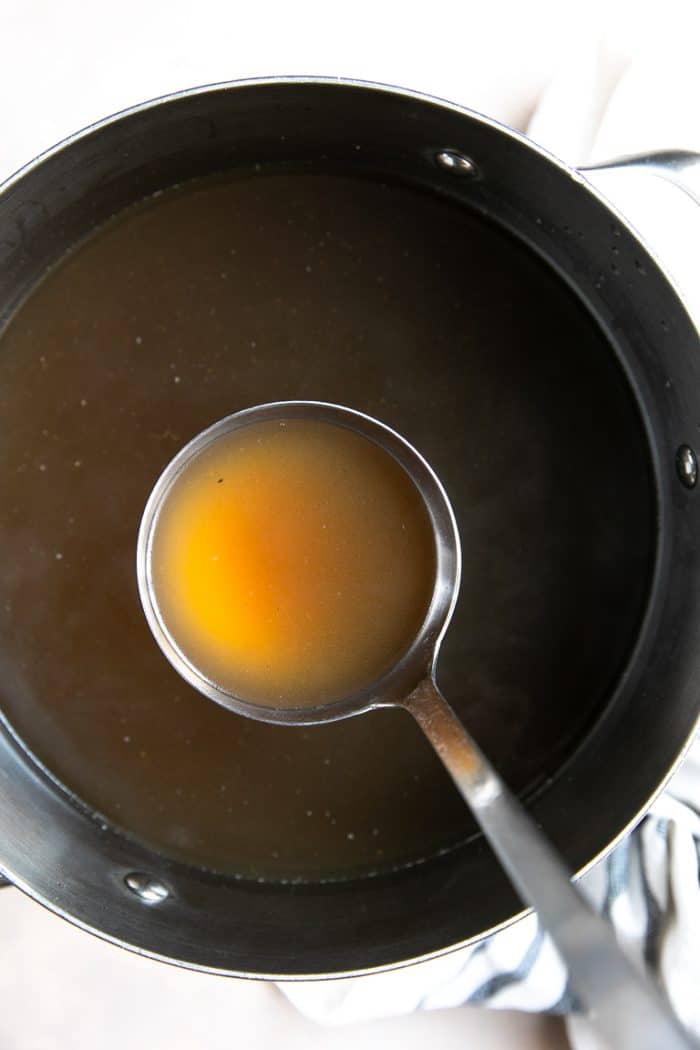
What is Pho?
Pho ( Phở)originated in the early 20th century in northern Vietnam. It is a Vietnamese soup consisting of broth,bánh phở (rice noodles), unproblematic herbs and vegetables, and meat. The blazon of meat typically found in Pho is usually eitherphở gà(chicken pho) or phở bò(beef pho).
You will find that different parts of Vietnam serve unlike styles with some regions offering a sweeter goop, unlike herbs, or wider noodles.
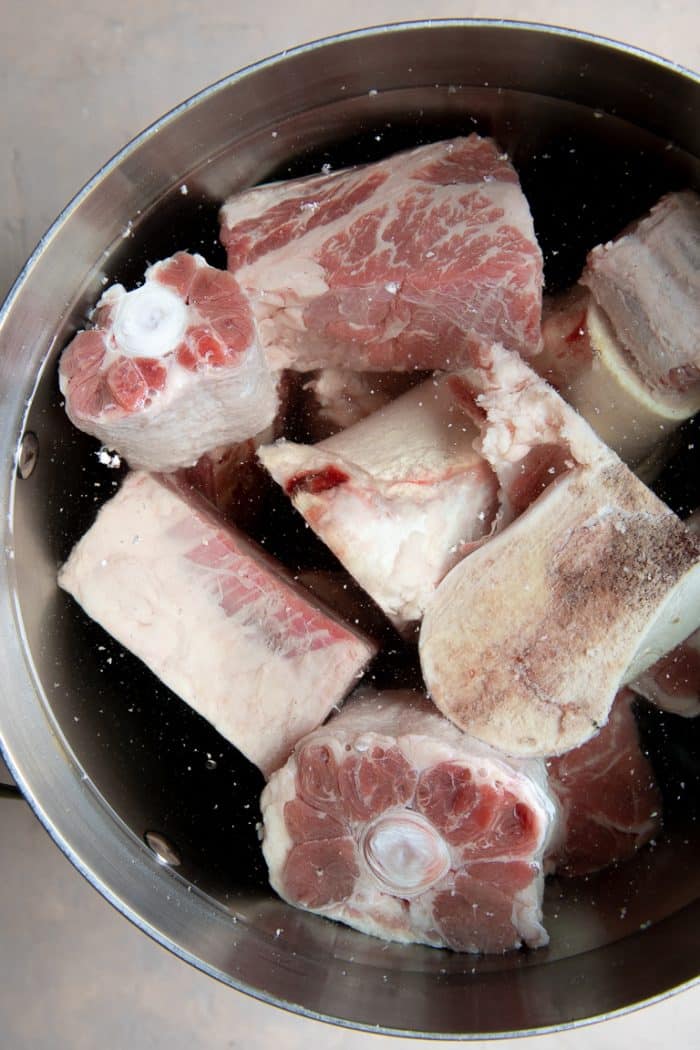
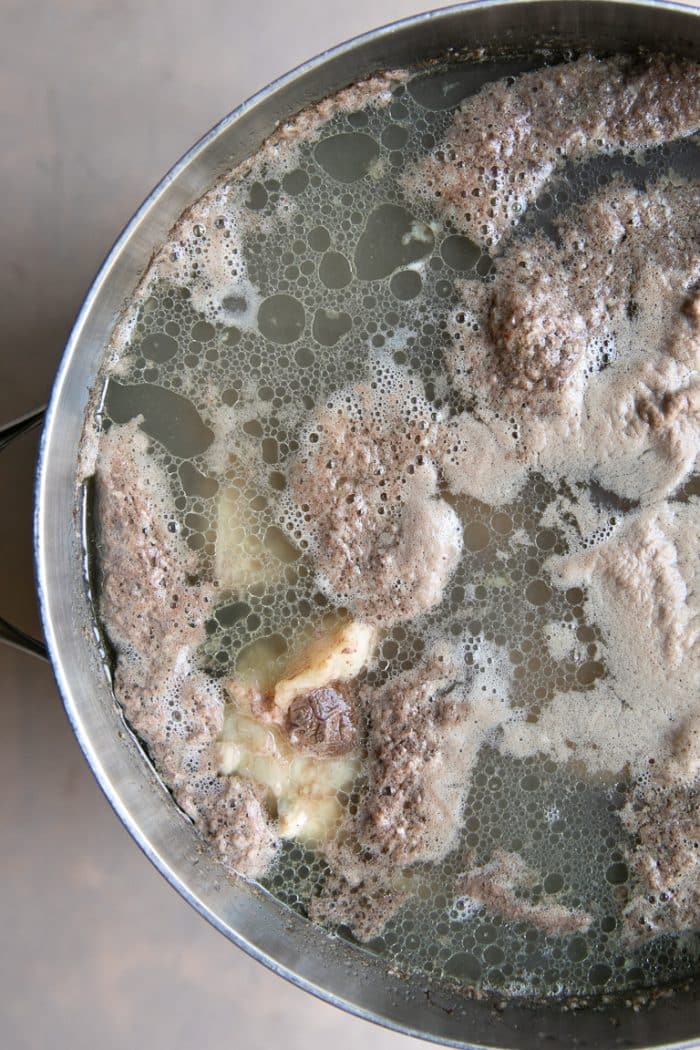
Pho Ingredients & Frequently Asked Questions
For this pho recipe, I chose to make phở bò, or beef pho. You can find about of the ingredients at your favorite grocery store, Asian supermarket, or online (like Amazon).
- Marrow bones and Meaty basic
- Thinly sliced raw meat
- Xanthous onions
- Whole garlic
- Fresh ginger
- Whole spices: star anise, cloves, cinnamon sticks, black cardamom pods, fennel seeds, coriander seeds
- Salt
- Fish sauce
- Sugar
What basic should I use to make pho goop?
The all-time beefiness pho goop is made using several different types of beefiness bones. I like to add together strictly marrow bones (no meat) and compact bones (bones with meat on them. Endeavour to incorporate a mix of knuckles, joints, feet, or marrow bones similar leg and shin bones that have been cut into smaller pieces. For added flavor incorporate meaty basic like oxtail, shank, and curt ribs. Yous can also toss in 2-3 pounds beefiness brisket or beef cheek, which adds astonishing flavor and provides leftover meat for sandwiches and soups.
How can I slice my raw beef super thin?
The easiest way to thinly piece tender raw beef is to partially freeze it before slicing. Conscientious not to freeze it all the way, though! Otherwise, it will be impossible to slice through. It'due south also helpful to have a recently sharpened knife.
Raw meat- what's the all-time cutting?
Boneless is easiest to slice. Flank steak, tri-tip steak, or brisket. Or, you tin splurge (recommended!) and add beef tenderloin – then yummy!
Call back – you lot're not cooking this meat before adding it to the soup. Instead, y'all will add to your bowl of noodles and pour your boiling broth directly over the top. The upshot is perfectly cooked medium-rare slices of meat.
Do yous have to blanch the bones? The answer is no. However, I recommend, particularly if you're you're making your broth from beefiness bones, that you lot do blanch them starting time. If you're using chicken basic or chicken anxiety- blanching is less important, but beefiness bones really demand this extra step, to remove impurities, coagulated poly peptide, and claret which ultimately results in a cleaner, better tasting broth.
Every bit far equally nutrient loss due to blanching? The nutrient loss is likewise small to justify not blanching (in my opinion).
The spices are really important
If you're wondering what sets pho broth autonomously from regular beef bone broth, it's all the added spices and aromatics. I know that there's a lot of them, but they're each incredibly important. So, if you're wondering if you can skip out on the spices and still have amazing broth, the reply is absolutely – but it won't be Vietnamese pho soup broth, it will but exist bone goop.
Besides, note that it'south a good idea to toast your spices in a dry out pan or skillet before adding them to your simmering pot. This simply helps intensify their flavors. Remember to pick upwards or club some cheesecloth (food form) and kitchen twine to wrap them in.
What noodles are used in pho?
Bachelor fresh and dried, these rice noodles typically come up in small, medium, and large widths. Fresh Bahn Pho Kho is typically pretty hard to locate outside of specialty supermarkets, so you'll probably discover yourself with dried noodles. That'due south ok- dried noodles are great. The best size for soup is either pocket-sized or medium.
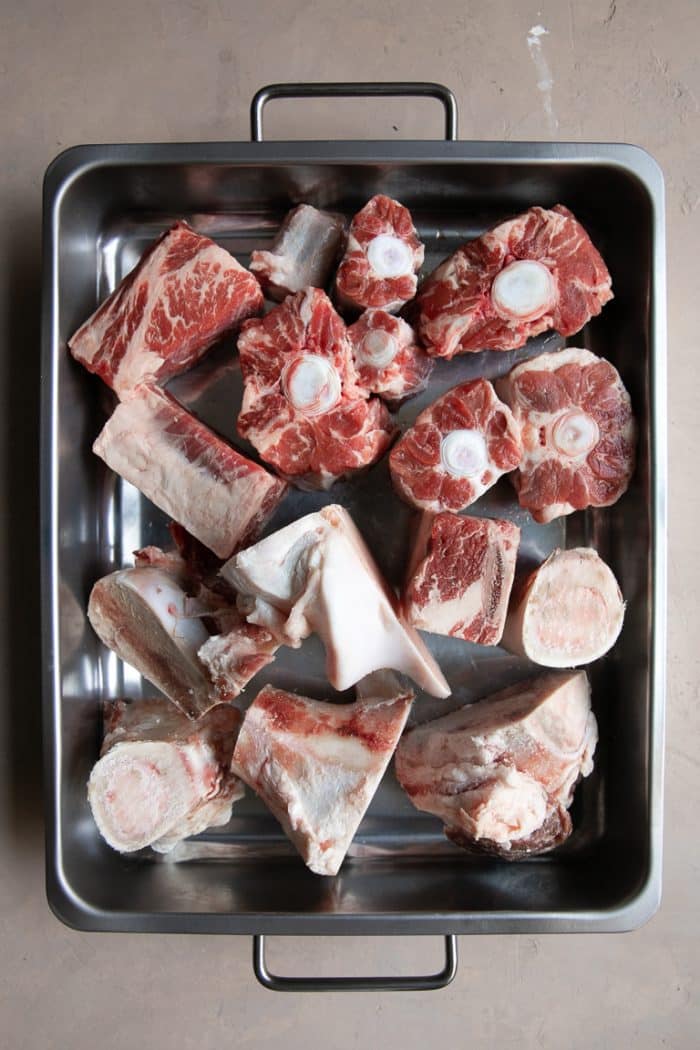
Pho Soup Garnishes
Basically, all the things you want to pile on tiptop of your soup. Think fresh, green, and healthy.
- Fresh mint
- Sprigs of Thai basil
- Fresh cilantro
- Green onions (scallions)
- Sliced white or ruby-red onion
- Fresh lime wedges
- Mung bean sprouts
- Sliced Thai red chiles
- Cabbage
- Bok choy
- Sliced Jalapeño
- Sriracha or other spicy chili sauce
- Hoisin sauce
- Fish sauce
You know, those things.
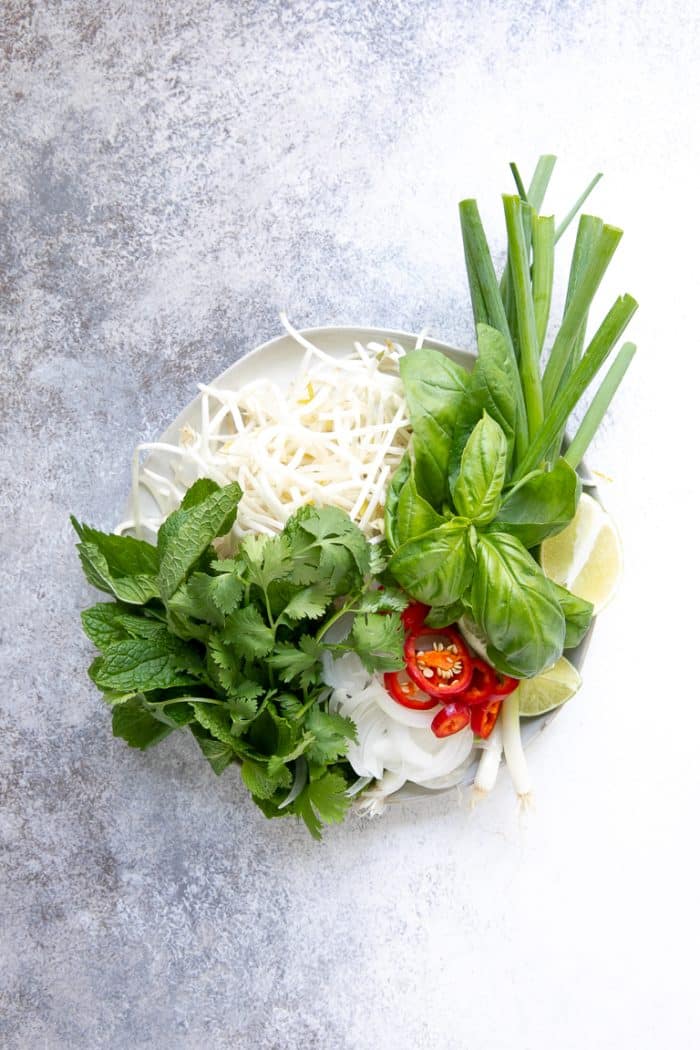
How to Melt Pho Noodles (Bahn Pho Kho)
As I discussed to a higher place, you'll want to become your easily on some rice noodles. These rice noodles are awesome equally they don't need to be boiled. Merely place in a pot of boiling water and allow them to rest for approximately 10 minutes before draining.
Do you have to use rice noodles? No, of class not. Just, they're highly recommended. Rice noodles are chewy, succulent, and made to go in Vietnamese noodle soups.
Can you boil the rice noodles directly in the broth? No. Well, I mean technically, yes. Only, no. Delight, boil or soak your noodles separately. Especially if you spent the hours and hours to make beautiful, articulate, delicious bone goop. If you melt directly in your broth information technology will make your broth cloudy and your noodles will (likely) fall autonomously or turn soggy over time.
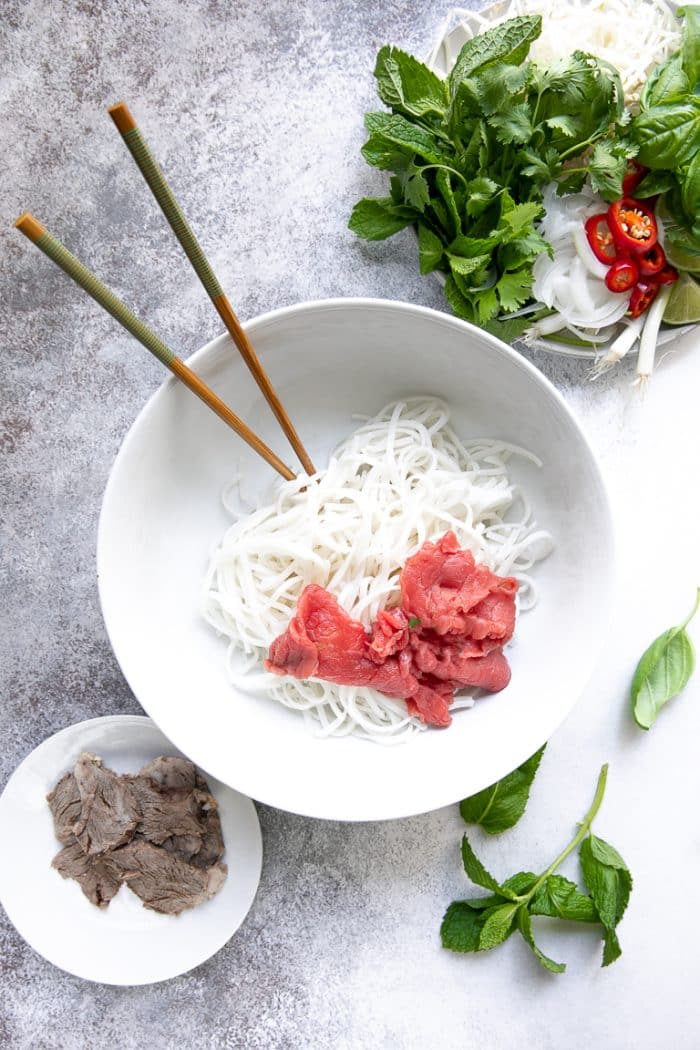
Assembling the Very Best Bowl of Pho
Like building the perfect sandwich, there is a right and a wrong way when constructing a bowl a pho.
The wrong way? Throw everything together. The right mode? Throw information technology all together, in a very specific guild.
- Pick a large enough bowl. Yous GUYS, Vietnamese noodle soup needs large bowls. Cereal bowls volition not work here. Between the noodles and the broth and the veggies, bowls fill upward fast.
- Rice noodles first. Add your pre-cooked noodles kickoff. My husband loves a whole lot of noodles, whereas I dearest actress veggies. Fill your bowl appropriately.
- Raw meat next. Yeah, you guys. RAW. Totally, completely uncooked (see higher up). Remember how I mentioned slicing your beefiness super (paper) thin? This is why. Don't worry, assuming your broth is boiling hot and not just warm, your meat volition go fully cooked.
- Add together the goop. Information technology doesn't thing which goop (the fast or the slow method), this is the moment. Just make sure it's super hot.
- Garnish like crazy. Add cooked beefiness from the basic you used to brand the os goop, add one sauce…or five. Guys, it's upwards to y'all! Have fun!
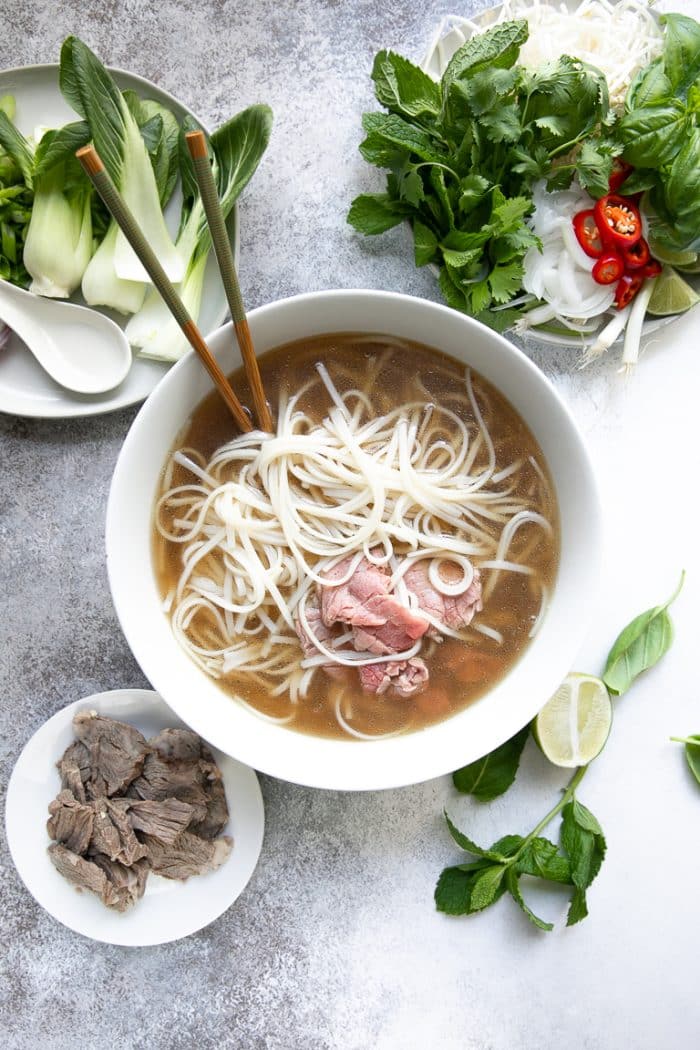
How to Store Leftover Pho Goop
Before storing your pho broth in the refrigerator or freezer you lot want to cool it down to room temperature. Ideally, you lot want to do this as rapidly as possible to foreclose whatsoever gamble of contagion. The easiest style to practise this is past adding a couple of handfuls of ice to the pot, covering, and waiting for the broth to cool. The ice helps expedite this process.
Or, as suggested by a reader, fill your sink or bathtub with a few inches of common cold water. Place the pot in the cold h2o and permit the broth to cool to room temperature.
Store the leftover broth in a large stockpot, in mason jars, or in glass storage containers. If you plan to freeze your broth, transfer desired amounts to large ziplock numberless with most of the air removed. Lay flat and let at least four-6 hours to freeze completely.
The leftover goop volition stay fresh for up to v days in the refrigerator and half-dozen months in the freezer.
I exercise NOT recommend freezing anything other than the pho broth. That means, no noodles and no veggies. Only the broth.
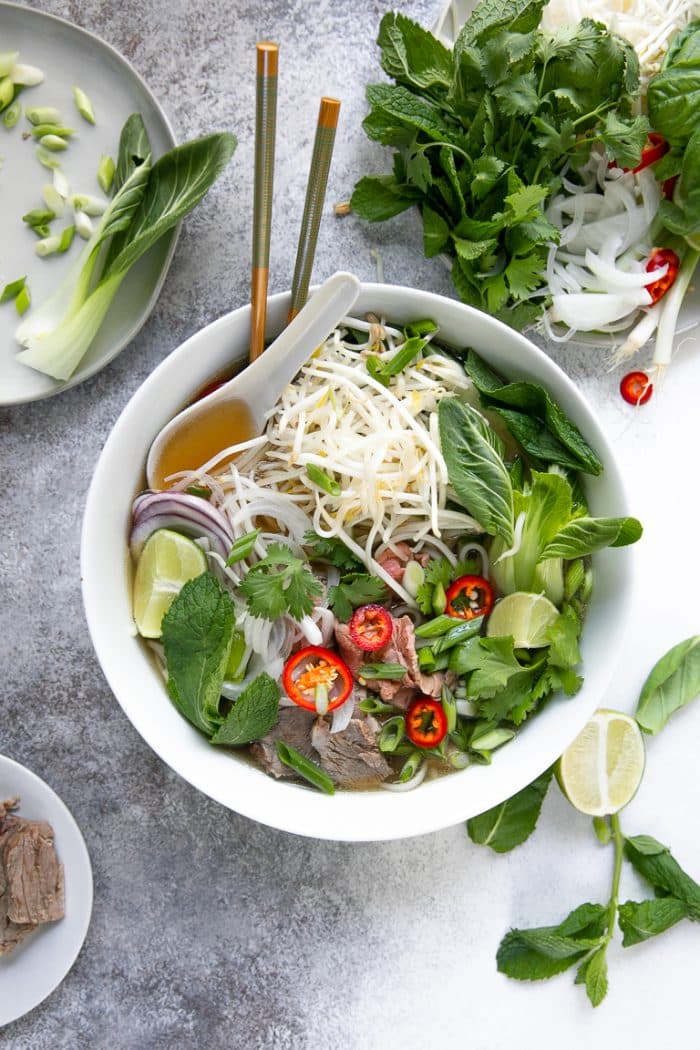
More than Soup Recipes,
Homemade Chicken Noodle Soup Recipe
Kimchi Ramen Noodle Soup (30 minutes)
Udon Noodle Soup with Bok Choy
Creamy Chicken and Wild Rice Soup Recipe
Easy Minestrone Soup Recipe (Stovetop + Slow Cooker)
If you try cooking this Pho Recipe (Vietnamese Noodle Soup) , please leave me a comment and let me know! I ever dearest to hear your thoughts.

REMEMBER TO SUBSCRIBE TO THE FORKED SPOON NEWSLETTER FOR Gratis AND RECEIVE WEEKLY RECIPE NOTIFICATIONS DELIVERED STRAIGHT TO YOUR INBOX!
If you try a recipe, please share it using the hashtag #theforkedspoon or by tagging @theforkedspoon on INSTAGRAM ! Follow The Forked Spoon on FACEBOOK | INSTAGRAM | PINTEREST for all of the latest recipes and updates.
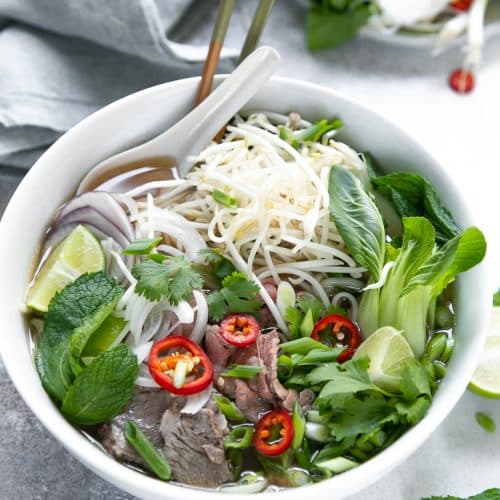
Pho Recipe (How to Make Vietnamese Noodle Soup)
Learn How to Make this Vietnamese Noodle Soup Recipe (Pho) correct in your own home with these easy to follow instructions.
Note- there are ii sets of instructions. The outset is for the more authentic pho broth (long version) and the second is for the less authentic (short version).
Accurate Pho Broth (viii+ hours)
- 10 pounds beef bones - preferably a mix of marrow bones (femur bones) and bones with meat on them (oxtail, brusque ribs, and knuckle basic cutting in half)
- 2 medium yellowish onions - pare and quarter
- two whole heads garlic - halved crosswise
- four (2-inch pieces) ginger - sliced lengthwise
- vi whole star anise
- 12 whole cloves
- 2 whole cinnamon sticks
- 2 black cardamom pods
- 2 tablespoon fennel seeds
- 2 tablespoon coriander seeds
- 2 tablespoon table salt - (plus more to taste)
- ⅔ cup fish sauce - divided between the two pots
- 4 tablespoon sugar - divided between the two pots
Non-Accurate Pho Broth (20-thirty minutes)
- i tablespoon olive oil
- 3 shallots - diced
- ane agglomeration green onions - chopped, dark-green and white parts divided
- iv cloves garlic - minced
- 2 tablespoon fresh ginger - minced
- vi cups low-sodium chicken goop - or water
- 2 whole star anise
- 1 tablespoon soy sauce
- 1 tablespoon fish sauce
Associates
- i pound flat rice noodles - stale or fresh
- 1 pound beef - flank steak, chuck roast, brisket, sirloin (sliced thin against the grain)
- sliced red or white onions
- fresh cilantro - chopped
For the Table
- fresh mint, Thai basil
- mung bean sprouts
- green onions - (scallions)
- sliced jalapeño
- lime wedges
- thinly sliced cherry chilis
- hoisin sauce
- fish sauce
- chili sauce
- bok choy
Foreclose your screen from going dark
Authentic Pho Broth (8+ hours)
-
Blanch the basic. This footstep is And so Important. If you want a clear, cute pho broth, blanch your bones. Do this by dividing the bones between 2 large pots or stockpots. Comprehend with cold h2o. Bring to a eddy over high heat and simmer for 15-twenty minutes. Drain and rinse the basic with water.
-
Roast the basic and the vegetables (optional). Preheat the oven to 450 degrees F. Transfer the basic, onion, garlic, and ginger to the roasting pans or rimmed blistering sheets (you lot'll probably demand ii). Don't pile them all on top of each other. Roast for thirty minutes earlier gently tossing the bones, and roasting for an additional 15-thirty minutes more (for a total of 45-sixty minutes).
-
Toast the spices. As the bones are roasting, add together all of your spices (the star anise, cinnamon, cloves, cardamom pods, coriander seeds, and fennel seeds) to a large, dry skillet over depression heat. Toast the spices, stirring often to prevent burning, until fragrant, approximately 5 minutes. Split up the spices in half. Cut cheesecloth into 2 small square pieces (approximately five-inches by 5-inches) each. Transfer the divided spices to the middle of each square. Get together at the meridian and secure with kitchen twine.
-
Transfer the roasted bones and veggies dorsum to the stockpots. Making sure to wash the pots later on the bones were blanched and tuckered. Transfer and carve up the roasted bones, onion, garlic, and ginger back to the stockpots. Scrape upwardly whatever remaining bits and juices left in the roasting pan using a metal spatula and a picayune water, if needed. Add to the pot with the bones (don't worry, all those brown bits are FLAVOR!).
-
Bring to a boil. With the basic, spice sachets (ane per pot), onion, garlic, and ginger divided betwixt the two pots, fill up each pot with approximately 12 cups water (or until bones are fully submerged), one/3 cup fish sauce and 2 tablespoons of sugar. Bring to a boil.
-
Simmer the basic. Immediately reduce rut to low and simmer, with the lid slightly ajar, skimming whatsoever foam or excess fatty, occasionally (if yous blanched your bones, y'all shouldn't encounter much foam). Simmer for at least 6-12 hours, ideally 24 hours (exercise not exit the stove running overnight. Simply absurd and store in the refrigerator and continue to simmer the side by side day). Add more water if needed to make sure the bones stay submerged.
-
Strain the broth. Once the bones have simmered and your hot broth is ready, strain it through a fine-mesh strainer or colander into a clean pot. This separates the pretty, clear broth from the bones and spices.
-
Season to taste. Add additional salt (you'll probably need a piddling), soy sauce, fish sauce, sugar or rock sugar (found at Asian markets), to taste. Set aside the broth to cool (if you lot're non using correct away) and reserve the basic.
-
Don't forget almost the meat. I tin can almost guarantee that there is a TON of succulent meat waiting to be picked from the bones. Don't allow it get to waste! Discard the meat-free basic, herbs, and other $.25 that were used to make the goop, but save the meat and add to sandwiches, wraps, salads, or dorsum to your broth.
-
Skim the fat from the top (optional). Add a couple of handfuls of ice to your broth to expedite cooling and embrace your pot with a lid. Transfer the broth to the refrigerator and allow the broth to absurd fully (this will take upwards of 6 hours or overnight). The consequence will be a difficult, thick layer of fat on the top and a lesser layer that is your pho broth (which should look similar gelatinous chocolate-brown jello). If desired use a fork to scoop off the top layer of fatty.
Non-Authentic Pho Broth (20-30 minutes)
-
Cook the mirepoix. To a medium stockpot over medium heat, add the olive oil and shallots. Cook the shallots for approximately v minutes, stirring often. Add together the white parts of a few greenish onions, the minced garlic, and ginger. Stir well to combine and melt for 1-2 more minutes.
-
Add pre-fabricated broth or stock. Add your favorite store-bought broth or stock to the pot and bring to a simmer.
-
Add some season. Add 1-2 whole star anise, soy sauce, and fish sauce to the goop. Embrace. Simmer for 15-20 minutes.
-
Remove the star anise. Try non to forget this part.
-
Flavor to sense of taste. When it comes to Pho, you do y'all. Add more than table salt, more than sugar, more fish sauce, etc.
Assembly
-
Slice your meat. Thinly slice your meat. If you're having trouble, place information technology in the freezer for 10 minutes which will brand it easier to slice.
-
Noodles commencement. Take hold of a big basin and separate the pre-cooked noodles between bowls.
-
Add the raw meat. Yep, you guys. RAW. Add the meat directly on top of the rice noodles. Don't worry, bold your broth is boiling hot and not just warm, your meat will become fully cooked.
-
Add the goop. It doesn't matter which broth (the fast or the slow method), this is the moment. Just make sure it'southward super hot and ladle direct over the meat.
-
Garnish like crazy. Add some extra cooked beefiness from the basic you used to make the bone broth, add one sauce…or five. Guys, it's upward to yous! Have fun!
- This recipe will require two (8+ quart) stockpots and two roasting pans or rimmed blistering sheets. You can easily cutting the recipe in half. However, pho soup freezes well and takes so much attempt, why not, right? You will also demand ane-2 large Roasting Pans or rimmed baking sheets.
- Servings amounts. Authentic Pho Broth (approximately eight large bowls or 24 cups of broth). Non-Accurate Pho Broth (approximately ii bowls of Pho).
Originally published November 30, 2018
Calories: 574 kcal | Carbohydrates: 8 grand | Poly peptide: 5 g | Fat: 57 one thousand | Saturated Fat: 0 1000 | Cholesterol: 0 mg | Sodium: 2179 mg | Potassium: 111 mg | Fiber: i g | Saccharide: five g | Vitamin A: 165 IU | Vitamin C: 1.9 mg | Calcium: 38 mg | Iron: iii.9 mg
(Nutrition information provided is an gauge and will vary based on cooking methods and specific brands of ingredients used.)
Mention @theforkedspoon or tag #theforkedspoon and please leave your star rating in the comment section below.
Source: https://theforkedspoon.com/pho-recipe/
0 Response to "Make Beef Bone Broth for Pho"
Post a Comment